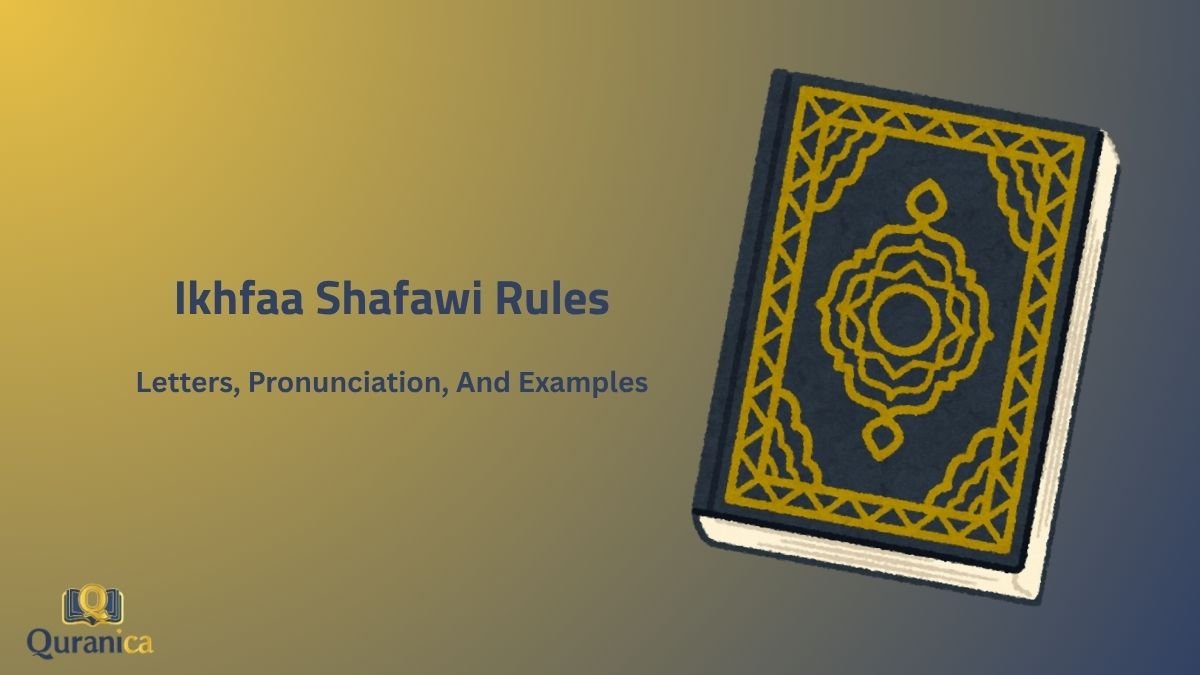Ikhfaa Shafawi is a Tajweed rule applied when a Meem Sakinah (مْ) is followed by the letter Baa (ب). Instead of pronouncing the Meem clearly or merging it, the sound is gently “hidden” using a soft nasal Ghunnah and light lip contact. It’s one of three rules governing Meem Sakinah pronunciation, alongside Idgham Shafawi and Izhar Shafawi.
One of the most important steps on the beautiful journey of Tajweed is mastering the pronunciation of a very common letter: the Meem Sakinah (مْ).
This silent Meem appears constantly throughout the Quran, and how you pronounce it can change the entire melody of a verse.
Today, we will walk you through one of its most important rules, a rule of gentle hiding and beautiful nasal sound known as Ikhfaa Shafawi.
Let’s start with the absolute basics, it’s all about a special letter: the Meem Sakinah.
Introduction To Meem Sakinah And Relationship to Ikhfaa Shafawi
A Meem Sakinah, written as (مْ), is simply a Meem that has a Sukoon over it. This Sukoon indicates that the Meem has no vowel sound (no a, i, or u sound).
Its own sound is just ‘m’. The way you pronounce this (مْ) changes depending on the very next letter in the verse, leading to three beautiful and distinct rules of recitation.
The Three Rules of Meem Sakinah
When you see a Meem Saakin (مْ) in the Quran, one of three things will happen. It all depends on the letter that immediately follows it.
These three rules are your complete guide to pronouncing the Meem Sakinah correctly every single time. They are:
- Ikhfaa Shafawi (الإخفاء الشفوي) – The Lip-based Hiding
- Idgham Shafawi (الإدغام الشفوي) – The Lip-based Merging
- Izhar Shafawi (الإظهار الشفوي) – The Lip-based Clarifying
This article will focus on the first rule, Ikhfaa Shafawi. To build a strong foundation and master all three, consider exploring Quranica’s Learn Tajweed for beginners Course, designed to guide you step by step.

Now, let’s zoom in on our main topic today. What exactly is Ikhfaa Shafawi?
What is Ikhfaa Shafawi?
Ikhfaa Shafawi is the rule of “hiding the Meem sound” with the lips. It happens when a Meem Sakinah is followed by one specific letter, which we’ll get to in a moment.
Why Was It Named Al-Ikhfaa Ash-Shafawi?
The name itself is a perfect description of the rule. Let’s break it down to truly understand its meaning.
Ikhfaa (Hiding): It’s called “hiding” because you don’t pronounce the Meem with complete clarity (like in Izhar), nor do you fully merge it into the next letter (like in Idgham).
Instead, you partially hide its sound by holding a gentle nasal sound, or Ghunnah.
Shafawi (Oral/Lip-based): The rule is described as “lip-based” for a simple reason: the letter Meem (م) is articulated by closing the lips (shafatan – شفتان).
Both the Meem and the letter that causes this rule are pronounced using the lips, making the action entirely oral.
The Letter of Ikhfaa Shafawi
The single letter of Ikhfaa Shafawi is the letter Baa (ب). Whenever you are reciting the Quran and see a (مْ) followed by a (ب), you know instantly that you must apply Ikhfaa Shafawi.
What Makes the Ikhfaa Shafawi Rule Apply?
You only need to look for one specific sequence. The rule of Ikhfaa Shafawi applies only when a Meem Sakinah (مْ) is followed immediately by the letter Baa (ب). That’s it. It’s the one and only condition for this rule.
This is the easiest part to remember, and it’s the core of the lesson.
How to Pronounce Ikhfaa Shafawi Correctly?
Now for the practical part: how do we actually produce this beautiful sound? It involves two simple actions working together.
1. The Position of the Lips in Ikhfaa Shafawe
To pronounce Ikhfaa Shafawi correctly, you bring your lips together for the Meem (مْ) sound, but without pressing them tightly.
The contact should be gentle and light, preparing them to articulate the Baa (ب) that follows.
2. The Ghunnah (Nasalization) in Ikhfaa Shafawe
The “hiding” of the Meem is achieved by producing a Ghunnah—a soft, humming nasal sound that flows through your nose.
You should hold this Ghunnah for a duration of two counts. This gentle nasal sound is what connects the Meem to the following Baa.
Perfecting the timing and quality of your Ghunnah is key. You can fine-tune this beautiful skill through guided exercises in Quranica’s Tajweed test and practice sessions.
For those seeking deeper mastery, the nuances of Ghunnah are explored in our Advanced Tajweed Course.

Ikhfa Shafawi Examples from the Quran
Let’s see this rule in action within the verses of the Quran. Notice the (مْ) followed by the (ب) in each example.
“تَرْمِيهِم بِحِجَارَةٍ”
tarmeehim bihijaratin
Striking them with stones of baked clay.
Here, the Meem Sakinah in “tarmeehim” is followed by the letter Baa in “bihijaratin,” triggering the Ikhfaa Shafawi rule.
“فَبَشِّرْهُم بِعَذَابٍ أَلِيمٍ”
fabashirhum bi’athabin aleem
So give them tidings of a painful punishment.
In this verse, the Meem Sakinah in “fabashirhum” is followed by the Baa in “bi’athabin,” requiring the application of Ikhfaa Shafawi.
“يَخْشَوْنَ رَبَّهُم بِالْغَيْبِ”
yakhshawna rabbahum bilghayb
Who fear their Lord unseen.
The Meem Sakinah in “rabbahum” meets the letter Baa in “bilghayb,” which is a clear sign to apply this rule.
“وَكَلْبُهُم بَاسِطٌ ذِرَاعَيْهِ”
wakalbuhum basitun thira’ayhi
And their dog stretching his forelegs.
You can see the Meem Sakinah in “kalbuhum” is followed by the Baa in “basitun,” making it a perfect example of Ikhfaa Shafawi.
“وَمَا هُم بِمُؤْمِنِين”
wa ma hum bimu’mineen
But they are not believers.
This is an example where the Meem Sakinah in “hum” is followed by the Baa in “bimu’mineen,” necessitating the hiding of the Meem with Ghunnah.
“وَمَن يَعْتَصِم بِاللَّهِ”
wa man ya’tasim billahi
And whoever holds firmly to Allah.
In this instance, the Meem Sakinah at the end of “ya’tasim” is followed by the Baa in “billahi,” a clear case for applying Ikhfaa Shafawi.
“إِنَّ رَبَّهُم بِهِمْ يَوْمَئِذٍ لَّخَبِير”
inna rabbahum bihim yawma’idhin lakhabeer
Indeed, their Lord, that Day, is fully Aware of them.
Here we see a double example. The Meem Sakinah in “rabbahum” is followed by the Baa in “bihim,” and the Meem Sakinah in “bihim” is followed by a Yaa, which is Izhar Shafawi. The Ikhfaa Shafawi occurs on “rabbahum bihim.”
Seeing these examples in context is the best way to learn. Mastering their practical application is a core focus of the Learn Quran with Tajweed course at Quranica.
The Other Rules of Meem Sakinah (Idgham Shafawi – Izhar Shafawi)
Now that you have a firm grasp of Ikhfaa Shafawi, let’s briefly meet the other two rules of Meem Sakinah. Understanding all three will give you a complete picture of how to handle this letter.
1. Idgham Shafawi (The Lip-based Merging)
Idgham means “to merge” or “to assimilate.” This rule applies when a Meem Sakinah (مْ) is followed by another Meem (م).
To pronounce it, you merge the first Meem into the second, creating one single, emphasized Meem held with a Ghunnah for two counts.
An example is in the phrase “لَكُم مَّا” (lakum ma). You would read it as “lakumma,” holding the stressed Meem sound.
2. Izhar Shafawi (The Lip-based Clarifying)
Izhar means “to make clear” or “to clarify.” This is the most common rule for Meem Sakinah. It applies when a (مْ) is followed by any of the remaining 26 letters of the Arabic alphabet (any letter except for a Baa or a Meem).
Here, you simply pronounce the Meem Sakinah clearly and distinctly from your lips.
An example is “أَنْعَمْتَ عَلَيْهِمْ” (an’amta ‘alayhim), where the Meem is pronounced clearly without change.
It’s common for learners to wonder about the fine line between hiding the Meem and merging it. Let’s make the distinction perfectly clear.
The Difference Between Al Ikhfa Ash Shafawi and Al-Idgham Ash Shafawi
The primary difference between Al Ikhfa Ash Shafawi and Al-Idgham Ash Shafawi lies in the action of the lips and the completeness of the sound change.
In Ikhfaa Shafawi, you “hide” the Meem by gently touching the lips and allowing a Ghunnah to flow. The Meem’s identity is still partially present before moving to the Baa (ب).
In Idgham Shafawi, you “merge” the Meem Sakinah completely into the next Meem (م). The lips close for the first Meem and remain closed, creating a single, more intense sound with a Ghunnah. It’s a complete assimilation of one letter into the next.
The Difference Between Al Ikhfa Ash Shafawi and Izhar Shafawi
So, what is the real difference between hiding the Meem and making it clear? The answer is simple and revolves around one key element: the Ghunnah.
With Ikhfaa Shafawi, the presence of a two-count Ghunnah (nasal sound) is essential. You soften the Meem sound, hold the Ghunnah, and then pronounce the Baa (ب). It creates a smooth, flowing connection between the two letters.
With Izhar Shafawi, there is no Ghunnah. Or rather, articulating the letter ‘Meem’ from its point of articulation without increasing the nasalization (ghunnah). We do not say without nasalization because the letter ‘Meem’ naturally has it, but without elongating it.
You pronounce the Meem (مْ) sound crisply and clearly from the lips and then move directly to the next letter.
What is The Difference Between Ikhfaa Shafawi and Ikhfaa Haqiqi?
While their names both contain “Ikhfaa” (hiding), they apply to different letters and have different triggers.
The most important distinction is this: Ikhfaa Shafawi is a rule of the Meem Sakinah (مْ). It is the “Lip-based Hiding” because the Meem is a lip letter. It is only triggered by one letter: the Baa (ب).
On the other hand, Ikhfaa Haqiqi (or “True Hiding”) is a rule of the Noon Sakinah (نْ) and Tanween. It occurs when a Noon Sakinah or Tanween is followed by any of the fifteen specific letters of Ikhfaa. The hiding here involves keeping the tongue away from the articulation point of the Noon while producing a Ghunnah, preparing for the next letter’s articulation point.
Common Mistakes in Ikhfaa Shafawi
While Ikhfaa Shafawi has only one condition, students sometimes make small, recurring mistakes when applying it.
Being aware of these common pitfalls is the first step to avoiding them and perfecting your recitation. Here are a few key things to watch out for.
1. Pressing the Lips Too Firmly
A very common error is shutting the lips tightly when pronouncing the Meem Sakinah. This produces a strong, fully pronounced Meem sound, which goes against the principle of “hiding.” The lip contact should be gentle and feather-light.
2. Leaving a Large Gap Between the Lips
The opposite mistake is also common. In an attempt to avoid pressing them, some students leave their lips too far apart.
This makes the sound incomplete and the transition to the Baa (ب) awkward. The correct way is a gentle touch or a minimal, almost non-existent gap.
3. Rushing or Prolonging the Ghunnah
The beautiful nasal sound, or Ghunnah, must be held for the correct duration—two counts. A frequent mistake is to cut it too short, which rushes the sound, or to hold it for too long, which can disrupt the rhythm of the verse.
4. Skipping the Ghunnah Entirely
Some beginners might pronounce the Meem and then move directly to the Baa without the connecting nasal sound.
This is essentially applying the rule of Izhar Shafawi (Clarifying), not Ikhfaa Shafawi (Hiding). Remember, the Ghunnah is the very essence of this rule.
Master Ikhfaa Shafawi and More with Quranica!
Learning Tajweed is a beautiful and rewarding act of worship that connects you more deeply to the words of Allah.
Rules like Ikhfaa Shafawi transform your recitation from simple reading into a spiritually uplifting and correct articulation, just as the Prophet Muhammad (peace be upon him) recited.
At Quranica, we are dedicated to making this journey accessible and effective for you. Our strength lies in our teachers.
- Our tutors are native Arab instructors.
- They are distinguished graduates of the prestigious Al-Azhar University.
- All our tutors hold an Ijazah, a certified license to teach the Quran, passed down through a chain of masters to the Prophet himself.
- They are highly experienced in teaching the Quran, Arabic, and Tajweed to non-Arabic speakers just like you.
With competitive pricing and flexible schedules, you can learn from the best, right from the comfort of your home.
Whether you’re interested in our popular Learn Quran with Tajweed, an intensive Quran Memorization (Hifz) Programs, or the advanced Ten Qirat, we have a path for you.
Explore our full range of courses.
Our courses include:
- Arabic-related courses: whether you are a beginner or mid-level. You can choose your level and start from it.
- Memorization (Hifz) Programs: Structured memorization plans that guide students through the Quran at their own pace, supported by experienced instructors.
- Tajweed Courses: Well-designed courses help Muslims to reach the right recitation of the Quran correctly.
- Islamic Studies Courses: These courses help you know more about Islam and Tafsir. This is important since you need to understand the Quran and reflect on your daily life.
Our teachers are carefully selected to be able to explain personalized programs that adapt to each student’s level and goals. They know how to teach a child or an adult, a beginner or an advanced learner. We provide the support you need to grow.Explore our full range of courses and start a free evaluation session.
Join a Quranica course today!

Conclusion
Mastering the correct pronunciation of Meem Sakinah (مْ) is a cornerstone of Tajweed. Among its three rules, Ikhfaa Shafawi teaches how to gently hide the Meem sound when followed by the letter Baa (ب).
The rule is called “Ikhfaa Shafawi” because it involves partial hiding (Ikhfaa) of the Meem sound and uses the lips (Shafawi) for articulation. It blends clarity and subtlety using a soft nasal tone, or Ghunnah.
To apply Ikhfaa Shafawi, simply look for a Meem Sakinah followed by a Baa. Gently close your lips without pressing and hold a two-count Ghunnah through your nose for a flowing sound into the Baa.
The article also contrasts Ikhfaa Shafawi with the two other Meem Sakinah rules: Idgham Shafawi (merging with another Meem) and Izhar Shafawi (clear pronunciation before any other letter).








0 Comments